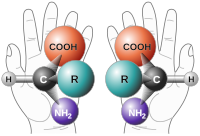Chirality (electromagnetism)

Chirality is like having a left and a right hand. Imagine your hands are identical, but if you try to put your left hand into a right-handed glove, it doesn't fit properly. This is because our hands, as well as many other things in the world, have a special characteristic called chirality.
In the world of electromagnetism, chirality is an important concept when we talk about light and how it interacts with molecules. Light is made up of waves, and these waves can have different orientations. Some waves may look like they are spinning clockwise, while others spin counterclockwise.
When light interacts with a chiral molecule, it can only interact with one orientation of the wave, either clockwise or counterclockwise. This means that the molecule will respond differently to each orientation of light wave, just like your left hand fits differently than your right in a glove.
This interaction between light and chiral molecules is what makes our eyes see different colors and shapes. For example, the difference between the smells of mint and caraway is due to the chirality of the molecules that make up these plants.
Chirality also has important applications in medicine and chemistry. Many drugs work because they can attach to specific molecules in our bodies, and these molecules often have a specific chirality. If a drug has the wrong chirality, it may not work or could even be harmful.
In summary, chirality is like having a left and a right hand and is an important characteristic of many things in our world, including light and molecules. Understanding chirality helps us better understand how things interact with each other, from light waves to the drugs we take.
In the world of electromagnetism, chirality is an important concept when we talk about light and how it interacts with molecules. Light is made up of waves, and these waves can have different orientations. Some waves may look like they are spinning clockwise, while others spin counterclockwise.
When light interacts with a chiral molecule, it can only interact with one orientation of the wave, either clockwise or counterclockwise. This means that the molecule will respond differently to each orientation of light wave, just like your left hand fits differently than your right in a glove.
This interaction between light and chiral molecules is what makes our eyes see different colors and shapes. For example, the difference between the smells of mint and caraway is due to the chirality of the molecules that make up these plants.
Chirality also has important applications in medicine and chemistry. Many drugs work because they can attach to specific molecules in our bodies, and these molecules often have a specific chirality. If a drug has the wrong chirality, it may not work or could even be harmful.
In summary, chirality is like having a left and a right hand and is an important characteristic of many things in our world, including light and molecules. Understanding chirality helps us better understand how things interact with each other, from light waves to the drugs we take.
Related topics others have asked about:
